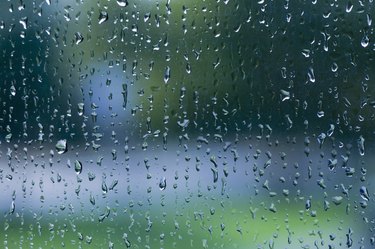
Inclement weather often catches contractors and homeowners alike by surprise and quickly brings a halt to outdoor construction projects. The vinyl siding you're installing will ultimately act as a shield to keep rain and cold winds from reaching the vulnerable wood boxing that covers the exterior shell of your house. If you're in the middle of the siding process when it starts raining, the boxing should be OK as long as you took the standard steps to protect it.
Boxing
Video of the Day
The two main types of boxing are plywood and oriented strand board, and both products come in large 4-by-8-foot sheets that attach directly to the wall studs. Made from laminated wood, both products will withstand and shed a small amount of moisture. Cut edges are more likely to swell, especially if the boxing is OSB. Contractors allow for slight expansion by installing the sheets one-eighth inch apart, but if a sheet swells more than that, it can heave and buckle.
Video of the Day
Moisture Barrier
House wrap goes over the boxing, and you'll install the vinyl siding on top. The wrap, which is water-resistant but "breathes," sheds rain very well. Rain runs between the unfinished siding and the house wrap to the bottom of the wall and out along the foundation. As long as the house wrap is in place, which includes installing wrap tape on the seams, the boxing is protected.
Resume Siding
After a rain, you can start siding again as soon as the previously installed siding and the house wrap are dry. It's always best to work with dry materials. If the uninstalled siding strips were left outside, the boxes will now be soggy and the strips will be wet. The water won't hurt them, but it can make them slick and hard to handle. Spread out half a dozen strips to dry, or quickly wipe each one to remove excess water. Make sure your chop saw or any other power saw is dry and that you're not standing in water when you use it.
Worst Case Scenario
Even when you take all the precautions you're supposed to take, something can go wrong. If high winds tore some of the house wrap off, the boxing in that area might suffer. If plywood or OSB boxing becomes saturated, the wood fibers can deteriorate. Once saturated, the boxing is no longer structurally sound and must be replaced. If you do have damaged boxing, in most cases only a sheet or two likely were affected where rain got through a tear or a badly taped seam.